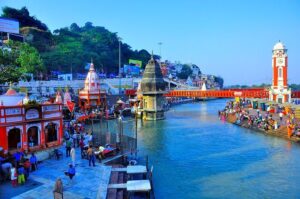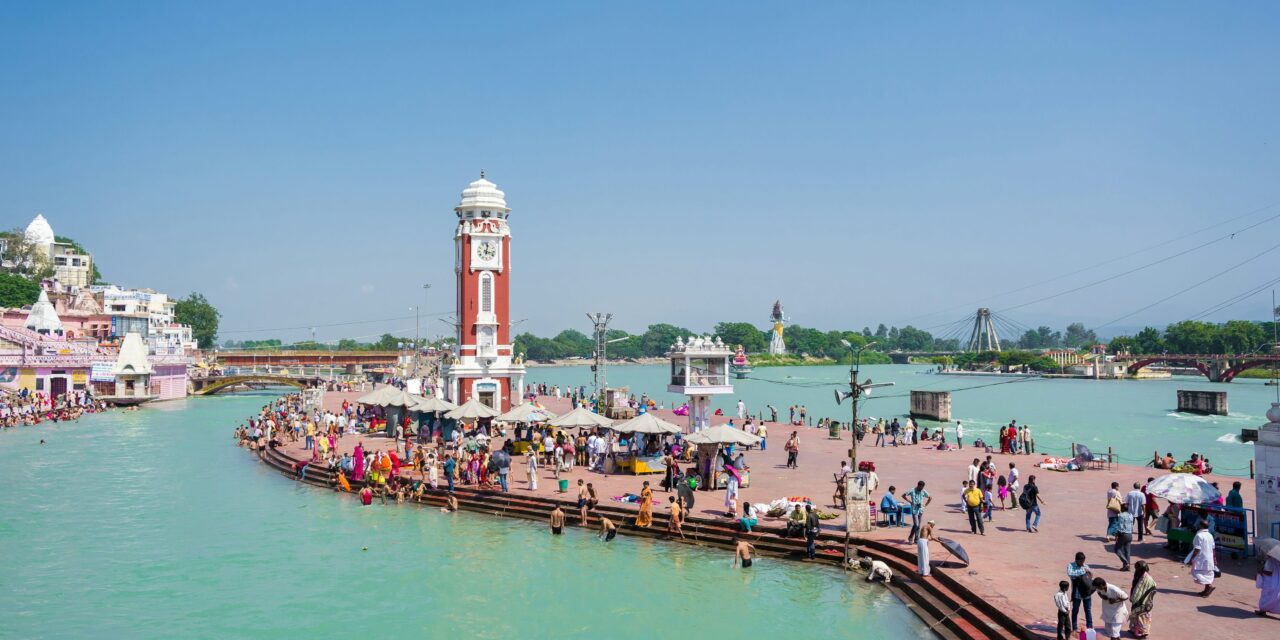Haridwar

Har Ki Pauri is a famous ghat on the banks of the Ganges in Haridwar, India
Haridwar, one of India’s holiest cities, is a sacred gateway to spirituality and devotion. Nestled along the banks of the Ganges River in Uttarakhand, it is renowned for the grand Ganga Aarti at Har Ki Pauri, where thousands gather to witness the mesmerizing ritual of fire and chants. This ancient city is a hub for Hindu pilgrimage, attracting devotees and seekers from across the world.
Haridwar is home to revered temples like Mansa Devi, Chandi Devi, and Maya Devi, each offering a deep spiritual experience. The Kumbh Mela, held every twelve years, is a massive congregation of saints and pilgrims. Beyond its religious significance, also a center for Ayurveda and yoga, with institutions like Patanjali Yogpeeth promoting wellness.
From its vibrant ghats to its rich cultural heritage, Haridwar is not just a place but an experience of faith, peace, and divinity, making it a must-visit destination.
The Spiritual Essence of Haridwar
Haridwar is among the seven holiest places in Hinduism and is believed to be one of the sites where drops of Amrit (nectar of immortality) fell from the celestial Kumbh. This event makes Haridwar a spiritually charged location, drawing millions of devotees seeking divine blessings and purification of the soul. The city is regarded as a gateway to the Char Dham Yatra, which includes Yamunotri, Gangotri, Kedarnath, and Badrinath—four of the most revered pilgrimage sites in Hinduism.
The sacredness is deeply embedded in its rituals, religious ceremonies, and the omnipresent chanting of Vedic hymns. Pilgrims visit Haridwar to take a dip in the holy Ganges, believing that the river’s divine waters cleanse one’s sins and lead to salvation (moksha). The presence of saints, sages, and ashrams adds to the city’s spiritual aura, offering seekers a place for meditation, self-discovery, and devotion.
Beyond temples and rituals, Haridwar is a center of knowledge and wisdom, with many ashrams dedicated to the teachings of ancient scriptures, yoga, and Ayurveda. The city’s divine vibrations can be felt in every corner, from its bustling markets selling religious artifacts to the peaceful ghats where spiritual seekers meditate in silence. Every aspect of radiates an energy that connects visitors to a higher consciousness, making it not just a pilgrimage site but a transformational spiritual retreat.
Har Ki Pauri – The Sacred Ghat
One of the most revered spots in Haridwar, Har Ki Pauri is the heart of the city. According to legends, Lord Vishnu’s footprint is imprinted on one of the stones at this ghat. It is believed that taking a holy dip at Har Ki Pauri cleanses one’s sins and grants liberation from the cycle of rebirth.
Every evening, thousands of devotees gather here to witness the grand Ganga Aarti, a mesmerizing ritual where priests perform synchronized prayers with large oil lamps, accompanied by chants and the rhythmic sounds of bells. The entire atmosphere is charged with divine energy, as the flickering flames of the aarti lamps reflect on the sacred waters of the Ganges. Devotees offer prayers, flowers, and floating diyas, creating a breathtaking view that symbolizes faith and devotion.
Apart from the evening aarti, mornings at Har Ki Pauri are equally serene and spiritual, as pilgrims perform rituals, take dips in the river, and engage in meditation. Many saints and ascetics can be seen offering prayers or sharing spiritual teachings with devotees. The ghat also serves as an important site for Pind Daan (rituals for ancestors), attracting people from across India seeking to honor their departed loved ones.

Har Ki Pauri is not just a religious landmark but also a cultural and historical treasure. The ghat hosts grand celebrations during festivals like Kumbh Mela, Ganga Dussehra, Kartik Purnima, and Diwali, when the entire city is illuminated with lights, diyas, and devotional fervor. The sight of millions of devotees congregating to seek blessings and witness the divine spectacle is truly awe-inspiring.
Major Temples and Religious Sites in Haridwar
Haridwar is home to numerous temples, each with its own significance and history. Some of the must-visit temples include:
- Mansa Devi Temple: Situated atop the Bilwa Parvat, this temple is dedicated to Goddess Mansa Devi, believed to fulfill the wishes of devotees. A cable car ride offers a picturesque view of the city and the river.
- Chandi Devi Temple: Perched on Neel Parvat, this temple is dedicated to Goddess Chandi, a fierce form of Durga. Like Mansa Devi Temple, this temple can also be reached via a cable car or a trek.
- Maya Devi Temple: One of the Shakti Peethas, this ancient temple is dedicated to Goddess Maya, the presiding deity of Haridwar.
- Daksha Mahadev Temple: A temple with historical significance, it is associated with the legend of Daksha Yagna and Goddess Sati.
The Kumbh Mela – A Grand Spiritual Gathering
Haridwar is one of the four cities that host the Kumbh Mela, the largest religious congregation in the world, held once every twelve years. Millions of devotees, saints, and sadhus gather to take a holy dip in the Ganges, believing that it purifies their sins and leads to salvation. The Kumbh Mela is an unparalleled spectacle of faith, spirituality, and Indian culture.
Yoga, Ayurveda, and Wellness in Haridwar
Beyond its religious significance, Haridwar is a hub for Ayurveda, yoga, and holistic wellness. The city is home to Patanjali Yogpeeth, an institute established by Baba Ramdev, offering Ayurvedic treatments, yoga sessions, and natural healing therapies. The serene environment makes it a perfect place for rejuvenation and self-discovery.
Local Cuisine – A Treat for the Taste Buds
Haridwar’s food scene is deeply influenced by its spiritual ambiance, offering a variety of vegetarian delicacies. Some of the must-try dishes include:
- Aloo Puri: A traditional North Indian dish enjoyed at local dhabas and eateries.
- Kachori Sabzi: A crispy, deep-fried delight served with spicy potato curry.
- Chole Bhature: A popular Punjabi dish loved by locals and tourists alike.
- Lassi and Rabri: Sweet and creamy drinks that provide a refreshing experience after a day of exploring.
Best Time to Visit Haridwar
Haridwar can be visited throughout the year, but the best time is during festivals like Kumbh Mela,
Major Temples and Religious Sites in Haridwar
Haridwar is home to numerous temples, each with its own significance and history. Some of the must-visit temples include:
- Mansa Devi Temple: Situated atop the Bilwa Parvat, this temple is dedicated to Goddess Mansa Devi, believed to fulfill the wishes of devotees. A cable car ride offers a picturesque view of the city and the river.
- Chandi Devi Temple: Perched on Neel Parvat, this temple is dedicated to Goddess Chandi, a fierce form of Durga. Like Mansa Devi Temple, this temple can also be reached via a cable car or a trek.
- Maya Devi Temple: One of the Shakti Peethas, this ancient temple is dedicated to Goddess Maya, the presiding deity of Haridwar.
- Daksha Mahadev Temple: A temple with historical significance, it is associated with the legend of Daksha Yagna and Goddess Sati.

The Kumbh Mela – A Grand Spiritual Gathering
Haridwar is one of the four cities that host the Kumbh Mela, the largest religious congregation in the world, held once every twelve years. Millions of devotees, saints, and sadhus gather to take a holy dip in the Ganges, believing that it purifies their sins and leads to salvation. The Kumbh Mela is an unparalleled spectacle of faith, spirituality, and Indian culture.
Yoga, Ayurveda, and Wellness in Haridwar
Beyond its religious significance, Haridwar is a hub for Ayurveda, yoga, and holistic wellness. The city is home to Patanjali Yogpeeth, an institute established by Baba Ramdev, offering Ayurvedic treatments, yoga sessions, and natural healing therapies. The serene environment of Haridwar makes it a perfect place for rejuvenation and self-discovery.
Local Cuisine – A Treat for the Taste Buds
Haridwar’s food scene is deeply influenced by its spiritual ambiance, offering a variety of vegetarian delicacies. Some of the must-try dishes include:
- Aloo Puri: A traditional North Indian dish enjoyed at local dhabas and eateries.
- Kachori Sabzi: A crispy, deep-fried delight served with spicy potato curry.
- Chole Bhature: A popular Punjabi dish loved by locals and tourists alike.
- Lassi and Rabri: Sweet and creamy drinks that provide a refreshing experience after a day of exploring.
Best Time to Visit Haridwar
Haridwar can be visited throughout the year, but the best time is during festivals like Kumbh Mela, Kanwar Mela, and Diwali when the city is at its spiritual peak. The winter months (October to March) are ideal for a comfortable and pleasant visit.
How to Reach Haridwar
Haridwar is well-connected by road, rail, and air:
- By Air: The nearest airport is Jolly Grant Airport in Dehradun, about 35 km away.
- By Train: Haridwar Junction is a major railway station with direct trains from major cities like Delhi, Mumbai, and Kolkata.
- By Road: Well-connected highways and frequent buses make traveling by road convenient.
Conclusion
Haridwar is not just a destination; it is an experience of faith, peace, and divinity. Whether you seek spiritual enlightenment, cultural richness, or a rejuvenating retreat, this holy city offers a unique blend of history, devotion, and natural beauty. A visit to is bound to leave you with a sense of inner peace and spiritual fulfillment. As you walk along its sacred ghats, listen to the chants echoing through the air, and witness the divine energy of the Ganga Aarti, you realize that is more than just a place—it is a journey of the soul. The city’s timeless traditions, unwavering devotion, and spiritual essence make it a destination that stays with you long after you leave. Whether you take a holy dip in the Ganges, visit its ancient temples, or simply soak in the peaceful atmosphere, Haridwar promises an experience that connects you to something greater than yourself.

Haridwar Map
Follow More Article







Recent Comments